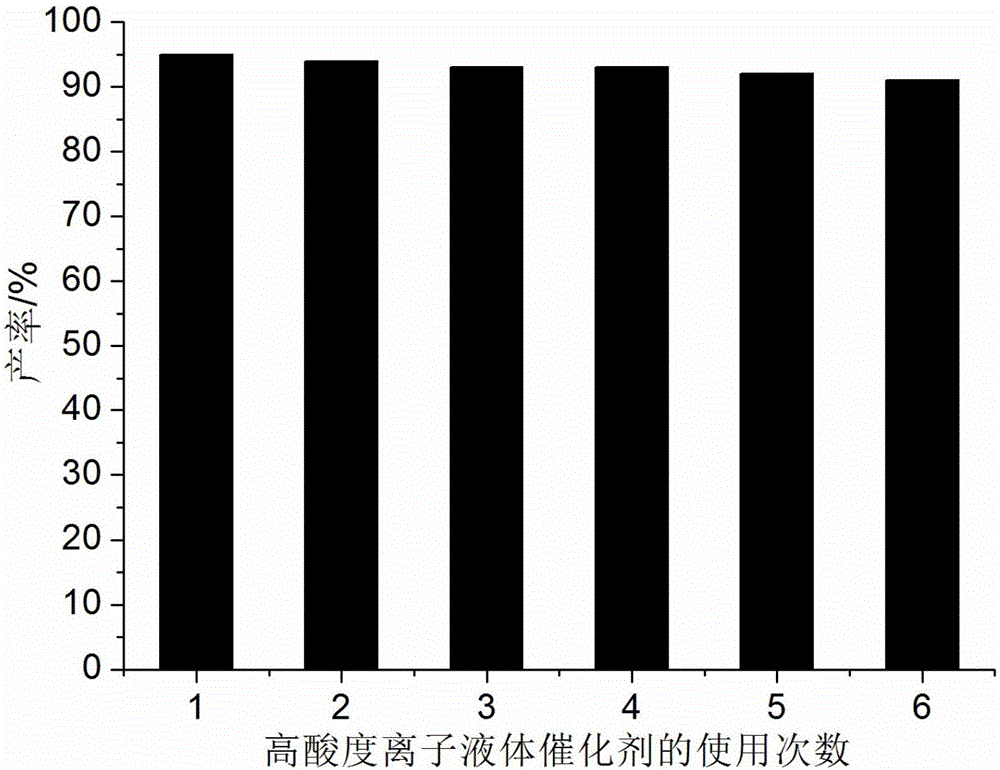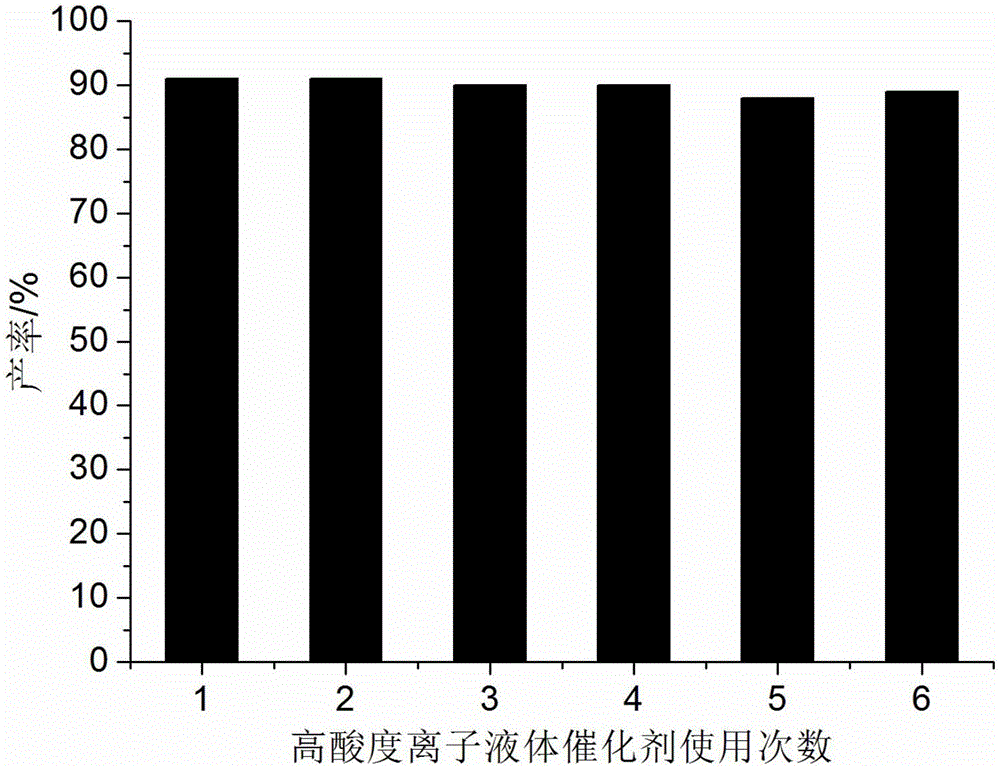Method for preparing hexahydroquinoline derivatives through high-acidity ionic liquid catalysis one-pot method
An ionic liquid, hexahydroquinoline technology, applied in organic chemistry and other directions, can solve the problems of ionic liquids that are not easy to biodegrade, low utilization rate of raw materials, cumbersome processing, etc., and achieves easy mass production, high utilization rate of raw materials, catalytic activity Good results
- Summary
- Abstract
- Description
- Claims
- Application Information
AI Technical Summary
Problems solved by technology
Method used
Image
Examples
Embodiment 1
[0025] 2mmol benzaldehyde, 2mmol 5,5-dimethyl-1,3-cyclohexanedione, 2mmol ethyl acetoacetate, 2.5mmol ammonium acetate and 0.05mmol high-acidity ionic liquid were added to 10ml of ethanol with stirring In a 50ml single-necked bottle with a sub and a condenser tube. Reflux reaction under vigorous stirring for 9 minutes, TLC (thin plate chromatography) detection, the raw material point disappeared, a large amount of solids precipitated after the reaction was completed and cooled to room temperature, crushed the solids, stood still, and suction filtered, and the resulting filter residue was vacuum-dried to obtain pure 2,7 , 7-trimethyl-5-oxo-4-phenyl-1,4,5,6,7,8-hexahydroquinoline-3-acetate, the yield was 95%. Add benzaldehyde, 5,5-dimethyl-1,3-cyclohexanedione, ethyl acetoacetate and ammonium acetate to the filtrate for repeated use.
[0026] 2,7,7-trimethyl-5-oxo-4-phenyl-1,4,5,6,7,8-hexahydroquinoline-3-acetate: m.p.206~208℃; 1 HNMR (300MHz, DMSO-d 6 ): δ=0.83(s, 3H), 1.02(...
Embodiment 2
[0028] 2mmol of p-chlorobenzaldehyde, 2mmol of 5,5-dimethyl-1,3-cyclohexanedione, 2mmol of ethyl acetoacetate, 2.5mmol of ammonium acetate and 0.05mmol of high acidity ionic liquid were added to the belt containing 12ml of ethanol In a 50ml single-necked bottle with a stir bar and a condenser. Reflux reaction under vigorous stirring for 8 minutes, TLC (thin plate chromatography) detection, the raw material point disappeared, a large amount of solids precipitated after the reaction was completed and cooled to room temperature, crushed the solids, stood, and suction filtered, and the obtained filter residue was vacuum-dried to obtain pure 4-( 4-Chlorophenyl)-2,7,7-trimethyl-5-oxo-1,4,5,6,7,8-hexahydroquinoline-3-acetate, yield 92% . Add p-chlorobenzaldehyde, 5,5-dimethyl-1,3-cyclohexanedione, ethyl acetoacetate and ammonium acetate to the filtrate for repeated use.
[0029]4-(4-Chlorophenyl)-2,7,7-trimethyl-5-oxo-1,4,5,6,7,8-hexahydroquinoline-3-acetate: m.p.244 ~246°C; 1 HN...
Embodiment 3
[0031] 2mmol p-nitrobenzaldehyde, 2mmol 5,5-dimethyl-1,3-cyclohexanedione, 2mmol ethyl acetoacetate, 2mmol ammonium acetate and 0.04mmol high acidity ionic liquid were added to the belt containing 14ml ethanol In a 50ml single-necked bottle with a stir bar and a condenser. Reflux reaction under vigorous stirring for 7 minutes, TLC (thin plate chromatography) detection, the raw material point disappeared, a large amount of solids precipitated after the reaction was completed and cooled to room temperature, crushed the solids, stood, and suction filtered, and the resulting filter residue was vacuum-dried to obtain pure 4-( 4-nitrophenyl)-2,7,7-trimethyl-5-oxo-1,4,5,6,7,8-hexahydroquinoline-3-acetate, the yield was 94 %. Add p-nitrobenzaldehyde, 5,5-dimethyl-1,3-cyclohexanedione, ethyl acetoacetate and ammonium acetate to the filtrate for repeated use.
[0032] 4-(4-nitrophenyl)-2,7,7-trimethyl-5-oxo-1,4,5,6,7,8-hexahydroquinoline-3-acetate: m.p. 245~247℃; 1 HNMR (300MHz, DMS...
PUM
 Login to View More
Login to View More Abstract
Description
Claims
Application Information
 Login to View More
Login to View More - R&D
- Intellectual Property
- Life Sciences
- Materials
- Tech Scout
- Unparalleled Data Quality
- Higher Quality Content
- 60% Fewer Hallucinations
Browse by: Latest US Patents, China's latest patents, Technical Efficacy Thesaurus, Application Domain, Technology Topic, Popular Technical Reports.
© 2025 PatSnap. All rights reserved.Legal|Privacy policy|Modern Slavery Act Transparency Statement|Sitemap|About US| Contact US: help@patsnap.com



